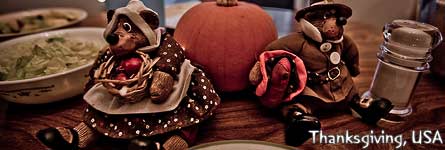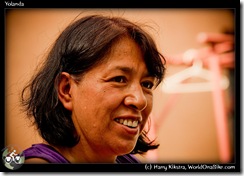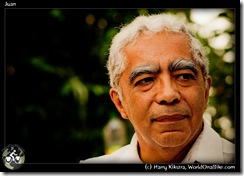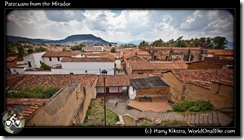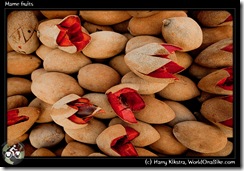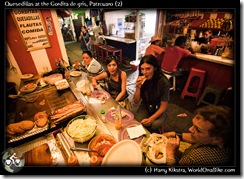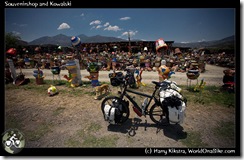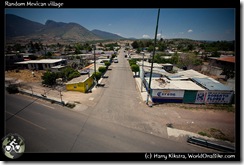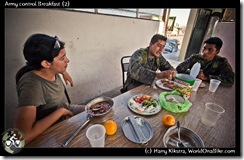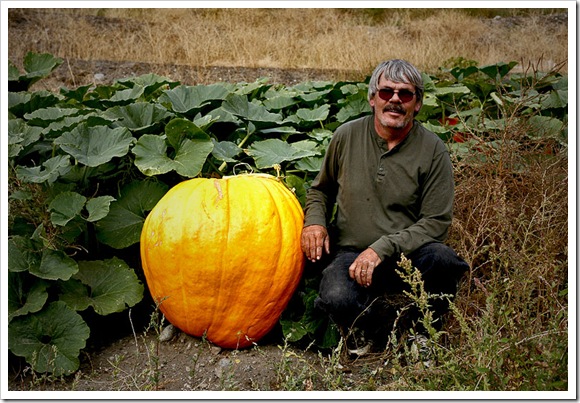Day 325-331, 1-7 June 2009: highland magic in Morelia
September 14, 2009 by Harry
Filed under Trip reports, Tips & Tricks, North America, Mexico, Central Mexico
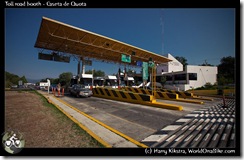 We were dropped off in the morning at our favourite pick-up spot: the tollbooth of the quota. For once we were not the only persons there without a car, as a demonstration of angry teachers was about to commence.
We were dropped off in the morning at our favourite pick-up spot: the tollbooth of the quota. For once we were not the only persons there without a car, as a demonstration of angry teachers was about to commence.
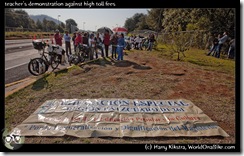 The toll roads in Mexico are very expensive, most truck drivers and definitely the underpaid teachers cannot afford to use them, so they were going to occupy the booths and let everybody go free as a protest.
The toll roads in Mexico are very expensive, most truck drivers and definitely the underpaid teachers cannot afford to use them, so they were going to occupy the booths and let everybody go free as a protest.
Unfortunately the guy that Ivana asked to give us a ride to Morelia had already paid. When he stopped to load our bikes in the back of the truck, he noticed the few dozen of people waiting and carefully asked ‘How many people need a ride again?’ 🙂
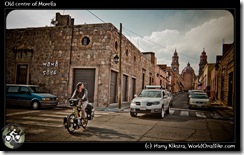 We had not expected to get to Morelia so soon, but it was nice to have some time to cycle through the old city. Morelia is one of the reasons people should visit Mexico: it has a wonderful historic centre, full of culture and with loads of buildings that are older than anything in the US. The university city is full of young people and there are plenty nice places to eat, drink or party if needed.
We had not expected to get to Morelia so soon, but it was nice to have some time to cycle through the old city. Morelia is one of the reasons people should visit Mexico: it has a wonderful historic centre, full of culture and with loads of buildings that are older than anything in the US. The university city is full of young people and there are plenty nice places to eat, drink or party if needed.
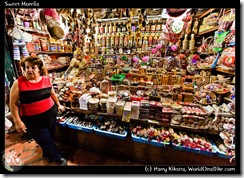 We had been invited by our new CouchSurfing friend Monica to stay with her family, we were already the 3rd cycling couple they had hosted. Monica and her family took great care of us and we stayed much longer than planned. We still had a deadline to meet, but the generosity of Monica, her mother Yolanda, father Juan and brother Juan Pablo kept us relaxed.
We had been invited by our new CouchSurfing friend Monica to stay with her family, we were already the 3rd cycling couple they had hosted. Monica and her family took great care of us and we stayed much longer than planned. We still had a deadline to meet, but the generosity of Monica, her mother Yolanda, father Juan and brother Juan Pablo kept us relaxed.
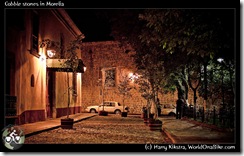 Yolanda is not just a great conversationalist with a lot of knowledge about history, culture and politics, but also a great cook. She surprised us every day with new local dishes, made with fresh and tasty natural ingredients only.
Yolanda is not just a great conversationalist with a lot of knowledge about history, culture and politics, but also a great cook. She surprised us every day with new local dishes, made with fresh and tasty natural ingredients only.
A welcome relief from the fast-food stores that are popping up everywhere in Mexico and from the pre-processed chemical packages that are sold as ‘food’ in the many small supermarkets. She even gives free classes about nutrition in schools and every meal was a feast.
We got to rest and recover from the hot Mexican coast My cut healed well and left only a small scar in the shape of a ‘7’, which is actually pretty cool 🙂
Patzcuaro, the magic town
When we mentioned that we would have to leave soon, they said that we could not go without seeing Patzcuaro, and they took us to this historic town between Uruapan & Morelia: one of the few dozen ‘Pueblos Magicos’, a list of less than 30 ‘magical cities’ of Mexico. Places that give you that special feeling…
We enjoyed the lake, ate real quesadillas on the market, had handmade ice-cream at the main square and admired the historic buildings and culture. Many local artists are producing and selling their artesanias on the streets and in little shops around town.

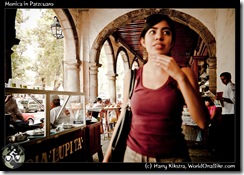
.
As in more historic places in Mexico it is illegal to have big loud advertising in the centre. All shops have the same colours and use the same fonts to advertise their name outside, which secures a wonderful low-key relaxed feeling.
So even though Burger King might have infiltrated in the main square commercial zone, you won’t know it is there until you are almost inside. But why eat there anyway, when there are delicious huge quesedillas for USD$0,50 and tons of unknown but cheap and tasty fruits instead?
Goodbye to Morelia
 Monica had already taken us a few times to some nice dinners and walks in the historic centre of Morelia and even organised a CouchSurfing meeting for us.
Monica had already taken us a few times to some nice dinners and walks in the historic centre of Morelia and even organised a CouchSurfing meeting for us. 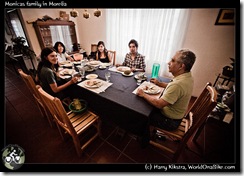
It was hard to say goodbye to this generous family, as many times before we felt we had taken more than we could give in return. We felt privileged to be a part of the family for while and to see yet another side of the diverse Mexican culture.
Back on the road again, heading for DF. Paletas & hills.
If you are in another country and you are heading for ‘Mexico’, you are heading for the country. Once you are there and you are still heading for ‘Mexico’, everybody knows you are going to the capital with the same name. I must admit that I knew nothing much more about Mexico City than that it is one of the largest cities in the world, with accompanying pollution and crimes. Recently, it was known as the ‘Swine flu capital’, though all news sources in Mexico report that the flu originated in the US, so who should you believe?
Anyway, as we always like to see things for ourselves rather than trusting media copycats, we decided that we should at least try to visit the Capital.
Monica & Yolanda guided us out of Morelia and pointed us to the new toll road. Unfortunately the arrogant boss of the accompanying complex would not let us cycle, nor leave us waiting for a ride. All the guards said that once the chief would be away, we would be fine. In the end we managed to ask for a ride and get our bikes loaded on a truck while the driver was paying his toll.
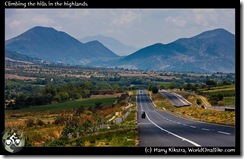 The car dropped us off at Zinepecuaro, where we enjoyed the first of many ‘paletas’, locally made ice-lollies made with big chunks of pure fruit, like Guanabana, coconut, pineapple or my favourite, mango with chile: cold, sweet and spicy!
The car dropped us off at Zinepecuaro, where we enjoyed the first of many ‘paletas’, locally made ice-lollies made with big chunks of pure fruit, like Guanabana, coconut, pineapple or my favourite, mango with chile: cold, sweet and spicy!
A steep road headed up to the main toll road between Guadelajara & Mexico city. The toll booth attendant did not even see us when we sneaked past. We could try to catch a ride here, but decided that we try some highland cycling instead. We regretted that soon as the next 15km was constant and very steep uphill. 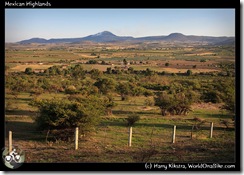
Even though we were at about 2400m/8000ft, it was hot and we had run out of water on the long climb. At the summit we got a bag full of sweet strawberries from a street vendor, which we enjoyed between the pine forests of the highlands.
After an initial downhill there was another smaller hill to climb but then we could enjoy our well-earned ‘free miles’, all the way down to the city of Maravatio. We cycled into town and saw the sign of the Cruz Roja, the red Cross.
If you are ever cycling in a town and have no idea where to stay safely and cheaply, here are some recommended choices, in no particular order, but generally valid all over the world:
- The fire station (Bomberos in Latin America). They usually have nothing much to do and enjoy the company, usually have some extra rooms or at least a safe place to camp
- The Red Cross: same as the Bomberos, + benefit of providing medical help if needed
- The Police: even though sometimes they have a bad name, generally speaking it is a lot safer to stay between police men than between the thieves they are trying to catch 🙂
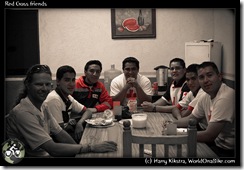 We got some water from the friendly nurses at the Cruz Roja and cooked our spaghetti outside the main entrance. Just after had put up our tent, the team leader cam out and offered us to stay inside instead and use the WiFi as well, which was of course gladly accepted.
We got some water from the friendly nurses at the Cruz Roja and cooked our spaghetti outside the main entrance. Just after had put up our tent, the team leader cam out and offered us to stay inside instead and use the WiFi as well, which was of course gladly accepted.
It was nice to see young (most were between 16 & 20) volunteers, trying to help out in the community, while being educated.
The following day we still had some free miles saved and the kilometres passed quickly through gentle hills and green fields passing over small towns.
It was still a long way to the City and so we stopped at the next tollbooth, where we got a ride fairly quickly. Fortunately we passed the busy madness of Toluca city, and got dropped off right in Metepec, where Monica’s aunt & uncle live.
When we cycled to the charming main square to call them for directions, a group of young cyclists came up and started asking questions about our trip. They were really interested and also used the opportunity to practice their English. They guided us through the small streets, stopping cars to let us pass easily and even called Monica’s family when needed. It was great to have such a young and enthusiastic cycling escort!
We were received with open arms by Laura & Roberto and their son Beto in their house outside of town. To the west we could see the impressive massif of Volcan de Toluca, to the east were the high mountains separating us from one of the largest urban zones in the world, currently feared by the world because of some strange virus… Mexico City, here we come!
Day 322-324, 29-31 May 2009: Hospitals, drunk rides and beach camps
September 12, 2009 by Harry
Filed under Trip reports, Tips & Tricks, North America, Mexico, Central Mexico
29th May 2009: Boca de Apisa – Maruata: 30km cycling, 2 rides, 3 hospitals, free breakfast, lunch and campsite on the beach
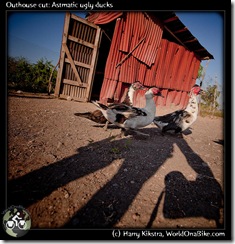 Ivana has a problem with birds. When they fly far away or sing cheerfully in the morning, she loves them, but when they get within her personal space they scare her. So when she had to go to the outhouse, where not only a toilet, but also half a dozen very ugly asthmatic ducks were to be found, she called in the troops.
Ivana has a problem with birds. When they fly far away or sing cheerfully in the morning, she loves them, but when they get within her personal space they scare her. So when she had to go to the outhouse, where not only a toilet, but also half a dozen very ugly asthmatic ducks were to be found, she called in the troops.
To chase the ducks away I walked around the toilet, but suddenly the rotten wood bottom gave away.
I did not know how deep the hole was nor what I would find inside, but as gross scenes from Slumdog Millionaire flashed through my mind, I instinctively held on to the side of the outhouse. 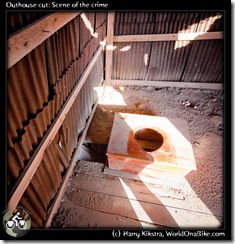
Unfortunately whomever build this construction had decided at some point that it would be better to use nails that are too long, rather than not long enough and my arm got stuck on the end of a nice long and rusty one. As I was still gravity-assisted and going down, it ripped my skin open, holding on to a few cm (1”).
While the bleeding slowly started I walked back out towards Ivana and told her I had cut my arm. The farmer had just come in as well and told us that the army checkpoint on the nearby road had a small hospital, so off we went.
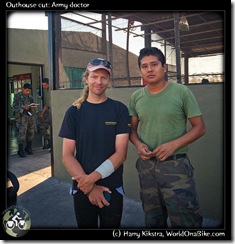 The Army doctor took a look and took me outside to clean the wound thoroughly with a healthy dose of pure stinging alcohol and a lot of pressure. As a small part of the skin was missing, he said that stitches probably would not work. He covered it with bandages, gave me some antibiotics and recommended to get a tetanus injection soon. Next patient please.
The Army doctor took a look and took me outside to clean the wound thoroughly with a healthy dose of pure stinging alcohol and a lot of pressure. As a small part of the skin was missing, he said that stitches probably would not work. He covered it with bandages, gave me some antibiotics and recommended to get a tetanus injection soon. Next patient please.
His fellow soldiers –they check cars and trucks for weapons and drugs- were interested in our trip and when we came back after packing our bikes they invited us for breakfast. We had had our breakfast half an hour before, but a real Bike Traveller never declines food.
We got some tortillas and beans, some meat and fresh juice, served with some nice chats about their work and our trip. To top it off they brought in a chilled guanabana, a large fruit with white flesh that was incredible tasty.
Even though I had some tetanus shots over a year ago in Argentina, a rusty nail in an duck-filled outhouse appeared to me the ultimate test that I did not want to fail, so it seemed like a wise idea to get another shot; there should be a hospital in the small village down the road.
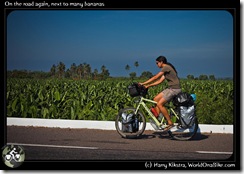 The village turned out to be quite big, noisy and polluted and off the road, but with some help we found the hospital, where I was given the tetanus shot right away. Back to the road again, through a nice flat section lined with banana trees.
The village turned out to be quite big, noisy and polluted and off the road, but with some help we found the hospital, where I was given the tetanus shot right away. Back to the road again, through a nice flat section lined with banana trees.
The next section was not just very hilly, but also known for its bandits and drug-traffickers, who use the small beaches on the rugged coasts to land their smuggling boats. We had planned to get a ride through this section as all the mafia apparently had attracted road-side robbers, attacking vehicles on the quiet road.
First we had to find a good place to hail a pick-up for a ride:
- The perfect spot is near a ‘tope (toh-pay)’, the annoying bumps that are placed on the road to slow down traffic. Cars have to almost stop here and it is easy to ask for a ride.
- If you are on a Quota/toll road, then the toll-both is perfect as well, assuming the guards let you stand there to ask.
- Near a corner, as most (not all) vehicles slow down in a curve, and we can see in time if it is a car or a full pick-up truck as it is no use to stop a car or a pick-up without space for our bikes.
- With sufficient open space for our bikes to be parked near the road and for the car to brake and pull-out.
- Not in a zone known for carjacking, drug trafficking & highway robbers as hitchhikers will be considered possibly dangerous and the cars offering a ride might be as well.
None of the above were available and while looking for them, the road started climbing without mercy. My arm hurt a lot when pulling at the handlebars at steep sections as there was tension on the fresh wound. Ivana’s knee was hurting again as well, so we just started asking passing cars while pushing our bikes up the steep slopes.
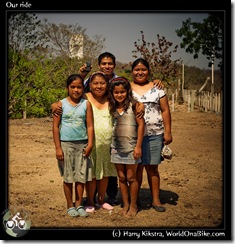 To our surprise a young girl, alone in a big pick-up, stopped and took us and our bikes. We picked her brother up on the way and they took us to their house, where their mum immediately invited us for lunch, treating us to quesadillas and avocado, yum!
To our surprise a young girl, alone in a big pick-up, stopped and took us and our bikes. We picked her brother up on the way and they took us to their house, where their mum immediately invited us for lunch, treating us to quesadillas and avocado, yum!
We could have camped with them, but wanted to get a bit further, so we headed back to the main road and pointed our thumbs towards the sky near a small road-shop.
After several hours of trying, alternating turns in the hot sun, a car truck stopped that could take us to Maruata, which sounded fine to us. What was less fine was that several cases of beer were emptied during the trip and while the road was curvy and bumpy, the speed picked up considerably.
We were sitting in the back with our bikes and were relieved when we arrived near the small town. The first thing we noticed was a huge new building, that turned out to be a newly-opened hospital. Perfect timing, as I wanted to change my bandages and check if my cut had not been infected. We walked in the near-empty building. It was dark as the night-nurses did not know yet where the main light switches were.
A friendly nurse cut away the bandages, took an interested glance at the nasty-but-not-infected-looking wound and then started scrubbing it with half a bottle of iodine using all of her force, suddenly looking a lot less charming.
While I was painfully getting cleaner than the brand new hospital floor, a 14 year old girl walked in crying, fully pregnant and about to deliver. We both looked at her and her crazy mother (or grandmother?) that just laughed like nothing was wrong in this picture. Again I realized the luxury that my so-called ‘problems’ would almost always be smaller than those seen around me.
When checking the prescription the doctor had written out for me, we noticed it was the same as the antibiotics we already had and so we left the 3rd hospital today without paying anything. All the treatments including the tetanus injection had been free of charge. Not just for me as a lucky tourist, but for everybody. Only if I had wanted to buy medication, I would have had to pay. How is that for a ‘developing country’?
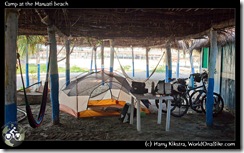 We cycled safely through the dark towards the beach on a bumpy trail, thanks to our headlights on our Santos bikes. Maruata beach is actually quite famous; for the surf and the turtles and it is simply pretty.
We cycled safely through the dark towards the beach on a bumpy trail, thanks to our headlights on our Santos bikes. Maruata beach is actually quite famous; for the surf and the turtles and it is simply pretty.
Now it was dark, but a few guesthouses and restaurants offered some light as well as some food and free camping. A couple of friendly salesmen that also had stopped here for the night offered to pay a room for us, but we explained that we rather be outside in our tent, as it would be cooler and without mosquitoes.
We fell asleep while the surf provided a lazy rhythm to the lightshows of the fireflies. Wat een dag!
30 May 2009: Maruata beach – Caleta de Campo: crazy hills, drunk rides and more beach
Our friendly host suddenly requested money for the free camping after all, but gave in after a brief protest from our side. We headed back up to the road and started cycling, again looking for a great place for our next ride.
There was none. This section of road was insane, a succession of incredibly steep climbs, directly followed by deadly downhills through blind corners on a narrow road with temperatures going through the roof. Rinse and repeat several dozen times. We now realized why the distance on the map had seemed wrong, but was right after all: if you could take this road and stretch it out, it would cover the true distance at least twice.
It would destroy the knees of Lance Armstrong, if he were able to get a fully loaded bike up here. So likely it would ruin ours as well and as the doctor had ordered rest for my arm we resorted to stopping pick-ups to force our next ride through this overheated madness.
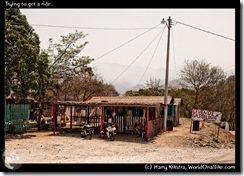 IOf course few people use this road for long-distance and it would take 5 separate rides that day before we would get to our next stop: one friendly guy, a drunk couple that picked us up twice, a trio of young girls in an expensive new truck and a nice man that turned out to be a drunk idiot as well, tossing out an empty beer can out the window every few minutes.
IOf course few people use this road for long-distance and it would take 5 separate rides that day before we would get to our next stop: one friendly guy, a drunk couple that picked us up twice, a trio of young girls in an expensive new truck and a nice man that turned out to be a drunk idiot as well, tossing out an empty beer can out the window every few minutes.
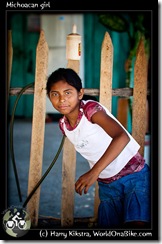 We still managed to cycle about 50km ourselves that day and even spend our lunchtime waiting several hours for a ride at a small place in the middle of nowhere where small kids were cycling downhill on a bike without brakes without wearing shoes, for fun.
We still managed to cycle about 50km ourselves that day and even spend our lunchtime waiting several hours for a ride at a small place in the middle of nowhere where small kids were cycling downhill on a bike without brakes without wearing shoes, for fun.
There we also got to chat with Orlando, an 80-year old Mexican that had great knowledge about geography and mountains all over the world. He was clearly very well educated, but now he just waited in the shade for his next customers: in exchange for free food and lodging, he sold gasoline for a local lady. Using his mouth and a hose he transferred the fuel into the expensive cars that stopped by, realizing that fuel stations were a rarity on this road.
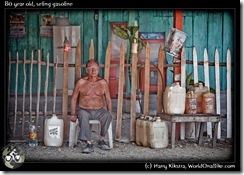 We saw his eyes gleam when we told him about our trip, but our heart broke every time he spent minutes coughing and spitting after every filling-up of yet another car filled with rude people. It was a sad sight, especially with the wrongly spelled ‘Cevende Gasolina’ sign on the road behind him (‘Se vende Gasolina = Gas for sale).
We saw his eyes gleam when we told him about our trip, but our heart broke every time he spent minutes coughing and spitting after every filling-up of yet another car filled with rude people. It was a sad sight, especially with the wrongly spelled ‘Cevende Gasolina’ sign on the road behind him (‘Se vende Gasolina = Gas for sale).
The last drunk ride had dropped us off in a beach town and a steep but paved road dropped us right onto the beach. Ivana was exhausted so I went to check the places to camp. 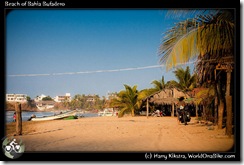 All the restaurants wanted cash to camp on their empty properties, even if we would buy dinner there. In the end the only place that would let us camp, was one that had the kitchen closed.
All the restaurants wanted cash to camp on their empty properties, even if we would buy dinner there. In the end the only place that would let us camp, was one that had the kitchen closed.
So we settled for a few emergency noodle soups and bought some cold beers to thank our hosts and quench our thirst Next door a children’s party hit a piñata (as well as one unfortunate small guest) to smithereens while thousands of small to medium-sized crabs that had appeared out of nowhere crawled around my feet, headed for the ocean. World On a bike in Mexico…
31 May 2009: Caleta de Campo beach – Uruapan: 80km + 200km in rides, up to the highlands!
The road had turned sane again and as our injuries felt better, we decided to make some more miles by ourselves again. The coastal road was a lot nicer here, with a fresh breeze coming up from the pretty beaches and hills that were doable for mortals.
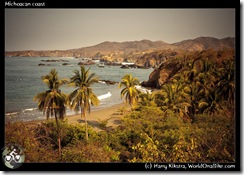 We did try to use ‘lunch’ -the hottest time of the day- for getting another ride as we were now less than one month away from our deadline in Cancun, so all bits would help.
We did try to use ‘lunch’ -the hottest time of the day- for getting another ride as we were now less than one month away from our deadline in Cancun, so all bits would help.
The small town was full of pick-ups, but it turned out that was just for the local fiesta, which in itself turned out to be a cockfight, illegal in the USA, a quite regular Sunday outing in Mexico.
Ivana talked to and helped some local kids that were trying to inflate a bicycle tire. Soon after they came up to me with their broken derailleur and a handful of parts. Though it had been a while since I fixed a derailleur as our Rohloff system has internal gears instead, I managed to turn into Bicycle Repairman and got all the parts connected and the gears going again.
I noticed that the initial joy on the little guy’s face had suddenly disappeared.
‘Comocuantovaser?’, he spoke swiftly but softly with a worried look on his face.
 Como cuanto va ser, or ‘how much is it going to be?’, we translated. Poor guy, he was afraid that the gringo would charge him a lot for fixing his bike.
Como cuanto va ser, or ‘how much is it going to be?’, we translated. Poor guy, he was afraid that the gringo would charge him a lot for fixing his bike.
I explained him that it was free and that cyclists should always help each other out when needed and his face cleared up to reveal a bright smile.
Closer to the larger city of Lazaro Cardenas we got 2 short rides across the busiest sections and they dropped us off at the new ‘quota’, the toll road that was not on our 2 maps. We cycled some more along the road, assuming we would at some point encounter a tollbooth.
We noticed that there was almost no trash near the road, a clear sign that it was just opened recently, as all other roads in Mexico are lined with plastic, glass, paper, more plastic and styrofoam. As friendly as the Mexicans are, their own environment is one thing they do not seem to care about. When cycling you really see the extent of the influence of plastic waterbottles & chips: free roadside marketing that shows that thousands of Coca-Cola drinkers have no respect for nature, not even their own.
When we finally got to the crossing where the booth was, some soldiers advised us not to go further east, but inland instead to visit Morelia and to enjoy the cooler air. We looked at our map and decided that it might be a good idea to head for the fresh highlands instead of following the bumpy hot coastline to Acapulco first.
The first pick-up Ivana asked already had some bags in the back, but still agreed to take us all the way to Uruapan. And so within minutes we speeded up on a brand-new road through the steep hills of the highlands, ending up nearly 1800m higher in the fresh world capital of avocado’s.
 The driver and his wife had planned to drop us off near a gas station, but intrigued by our little business-card they decided to invite us in their house instead.
The driver and his wife had planned to drop us off near a gas station, but intrigued by our little business-card they decided to invite us in their house instead.
We had a pleasant evening with the family Mendez. Again we ended up staying freshly showered and well-fed in the clean beds of new friends, wondering what the highlands of Central Mexico had in store for us…
1000 Americans: Mike Rice, Hilltop gardens, Thompson Valley, British Columbia
October 4, 2008 by Harry
Filed under 1000 Americans, Tips & Tricks, Go green
‘Somehow it just gets warmer here than anywhere around in BC. We tried growing some chili peppers this year and they do great. Currently we have so much fruit that needs to be picked, problem is to find people helping us!”
“Most of it is completely organic, but to get certified costs too much, it is not worth it…”
Tip for cyclists: when going down through BC and passing the Thompson valley (between Prince George & the Fraser Canyon leading to Vancouver), reserve a week to work for Mike, anytime between August & October. He will supply a free camp ground with showers and you can make $100/day picking apples, peppers and all kinds of other fruits and veggies. It is a beautiful area, so it might be nice to stay for a week or so and make enough to go biketravelling for more than 2 months…


